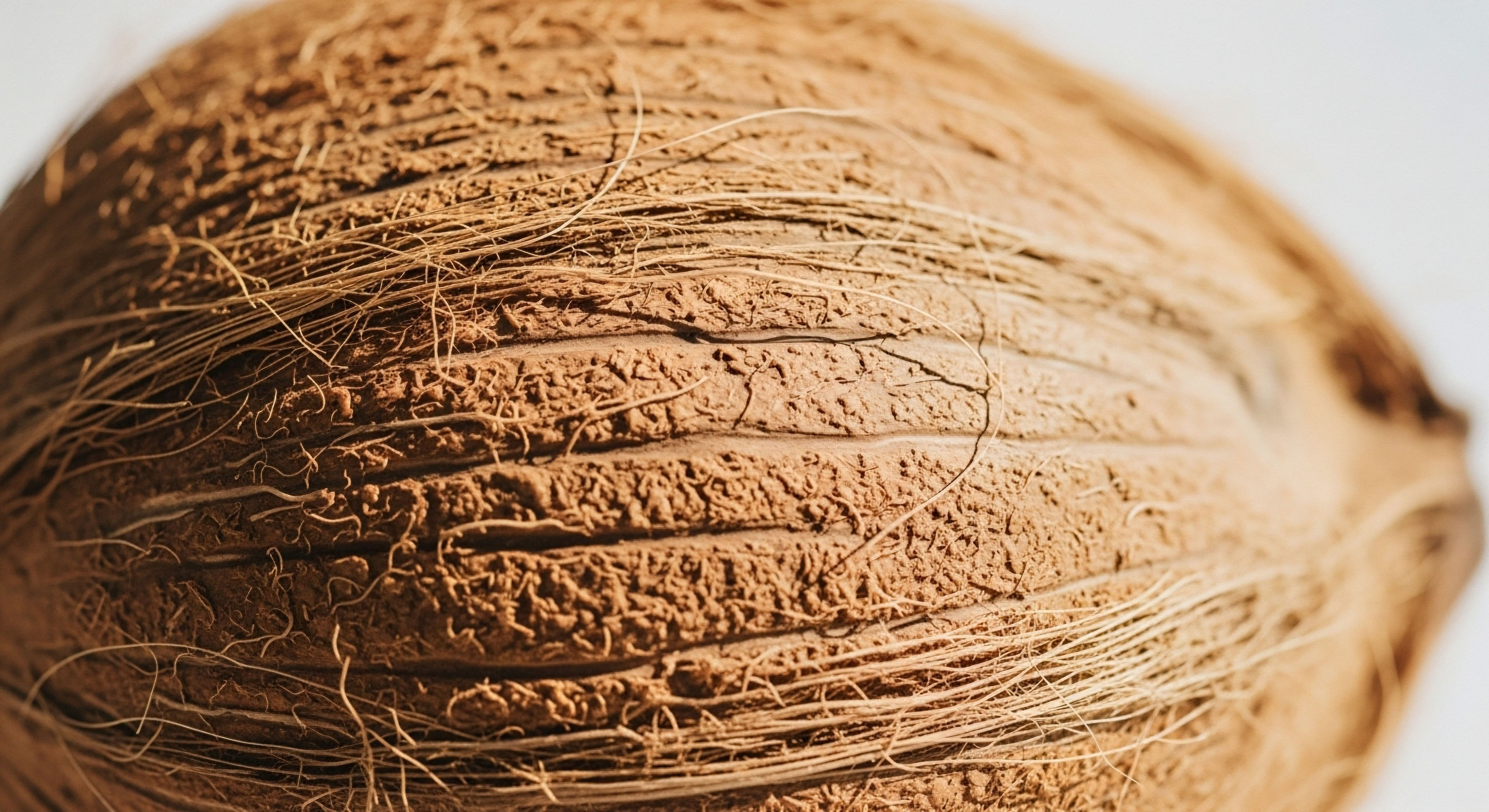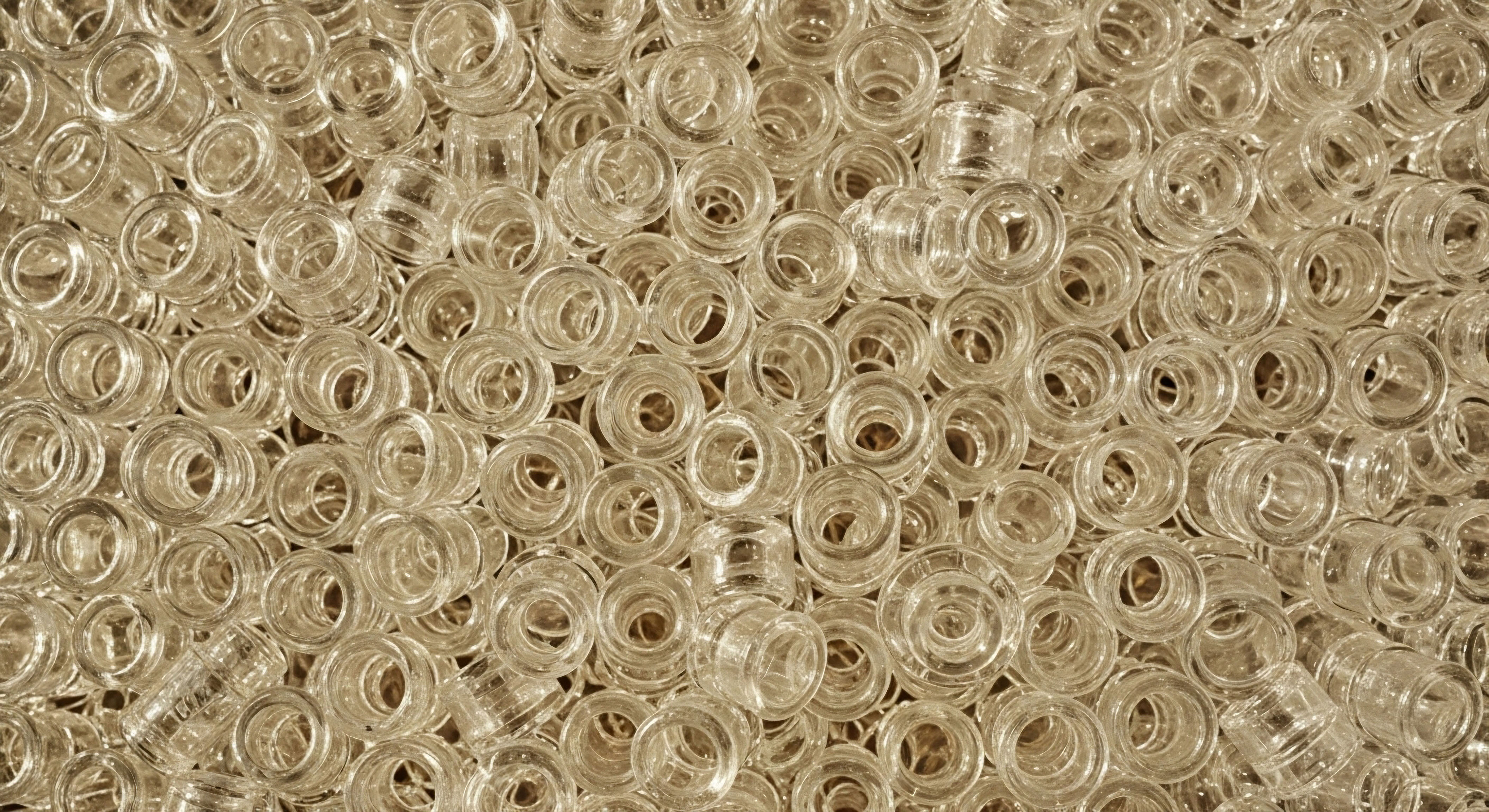

Fundamentals
You may feel the persistent hum of stress as a familiar, unwelcome companion in your daily life. It manifests as tension in your shoulders, a quickened pulse, or a mind that refuses to quiet at night. You might have noticed a connection between prolonged periods of high pressure and changes in your digestion or eating habits.
This connection is not a coincidence; it is a conversation happening deep within your body, a dialogue between your gut and your brain. Understanding this dialogue is the first step toward recalibrating your body’s response to stress. The food you consume, specifically dietary fiber, plays a profound role in modulating this internal communication system.
Your body has a primary stress response system called the hypothalamic-pituitary-adrenal (HPA) axis. Think of it as your internal command center for managing threats. When you perceive a stressor ∞ be it a looming deadline or a physical danger ∞ this axis is activated.
The final step in this cascade is the release of cortisol from your adrenal glands. Cortisol is a powerful glucocorticoid hormone that prepares your body for a “fight-or-flight” response by mobilizing energy stores and heightening your alertness. This system is elegantly designed for short-term survival. Chronic activation, however, leads to sustained high levels of cortisol, which can disrupt nearly every system in your body, contributing to feelings of anxiety, fatigue, and metabolic disturbances.
The communication between your gut and brain is a critical pathway influencing your body’s hormonal response to stress.

The Gut as an Endocrine Organ
Your gastrointestinal tract is much more than a simple tube for digestion. It is a dynamic and intelligent organ, home to trillions of microorganisms collectively known as the gut microbiome. This microbial ecosystem is so influential that it functions like an endocrine organ itself, producing and modulating hundreds of neuroactive compounds and hormones that signal directly to your brain.
Dietary fiber is the primary fuel source for these beneficial microbes. When you consume fiber-rich foods like vegetables, legumes, and whole grains, you are feeding this internal army of allies.
These microbes ferment dietary fibers, breaking them down into powerful metabolites called short-chain fatty acids (SCFAs). The most well-studied of these are butyrate, propionate, and acetate. These molecules are the language your gut microbiome uses to speak to the rest of your body, including your brain and your adrenal glands.
They are absorbed into your bloodstream and travel throughout your body, exerting influence on inflammation, immune function, and, critically, the HPA axis. By nourishing your gut microbes with fiber, you are directly supporting the production of compounds that help regulate your stress response from the inside out.

How Does Fiber Begin to Calm the Stress Response?
The influence of fiber on stress hormones begins with the simple act of feeding your gut bacteria. A well-nourished microbiome produces a steady supply of SCFAs, which help maintain the integrity of your gut lining. This strong barrier prevents inflammatory molecules from leaking into your bloodstream, a condition that can trigger HPA axis activation.
Furthermore, SCFAs can directly signal to the brain via several pathways, including the vagus nerve, a major nerve connecting the gut and the brainstem. This communication helps to soothe the nervous system and dampen excessive cortisol production. A healthy gut environment, cultivated through a fiber-rich diet, creates a foundation for a more resilient stress response system, allowing your body to return to a state of balance more efficiently after a stressful event.


Intermediate
To appreciate the sophisticated relationship between dietary fiber and stress hormone regulation, we must examine the specific mechanisms through which the gut microbiome communicates with the HPA axis. This process involves distinct types of fiber, the specific actions of the resulting short-chain fatty acids, and their ability to modulate the body’s central stress management system. The conversation is biochemical, intricate, and profoundly impactful on your physiological and psychological well-being.
Dietary fibers are broadly classified based on their solubility in water ∞ soluble and insoluble. Each type interacts differently with your gut microbiome and contributes to hormonal balance in unique ways. Insoluble fiber, found in foods like wheat bran and nuts, adds bulk to stool and promotes regularity.
While less directly involved in SCFA production, it supports overall gut health, which is a prerequisite for a balanced stress response. Soluble fiber, abundant in oats, barley, apples, and beans, forms a gel-like substance in the digestive tract. This type of fiber is particularly effective at being fermented by gut bacteria into SCFAs, making it a key player in the gut-brain dialogue.
Short-chain fatty acids produced from fiber fermentation act as critical signaling molecules that can directly temper the activity of the HPA axis.

The Role of Short-Chain Fatty Acids in HPA Axis Modulation
Once produced in the colon, SCFAs like butyrate, propionate, and acetate become central figures in regulating stress. They operate through several parallel pathways to influence the HPA axis and cortisol output. A primary mechanism is their ability to strengthen the intestinal barrier. Butyrate, for instance, is the preferred energy source for colonocytes, the cells lining your colon.
A well-fueled and robust gut lining prevents endotoxins, such as lipopolysaccharide (LPS), from entering circulation. Systemic exposure to LPS is a potent activator of the immune system and the HPA axis, so by preventing this leakage, SCFAs reduce a major source of physiological stress.
Beyond the gut, SCFAs travel through the bloodstream and can cross the blood-brain barrier, allowing them to exert direct effects within the central nervous system. Inside the brain, they function as signaling molecules. Butyrate, for example, is a histone deacetylase (HDAC) inhibitor.
This epigenetic mechanism allows it to influence gene expression, including genes related to neuroplasticity and stress resilience. By modifying the expression of key genes in the hypothalamus and pituitary gland, butyrate can help normalize the HPA axis response, preventing the excessive release of cortisol during stressful periods.

Comparing Fiber Types and Their Primary Functions
Understanding the different contributions of various dietary components helps in formulating a nutritional strategy for stress management. The following table outlines the characteristics of different fiber types and related nutrients that influence cortisol regulation.
| Component | Primary Sources | Mechanism of Action | Impact on Stress Regulation |
|---|---|---|---|
| Soluble Fiber | Oats, barley, nuts, seeds, beans, lentils, peas, and some fruits and vegetables. | Fermented by gut bacteria to produce high levels of SCFAs (butyrate, propionate, acetate). | Directly modulates the HPA axis, reduces inflammation, and strengthens the gut barrier. |
| Insoluble Fiber | Whole grains, wheat bran, nuts, beans, and vegetables like cauliflower and green beans. | Adds bulk to stool, promotes gut motility, and supports a healthy gut environment. | Indirectly supports stress regulation by maintaining overall gut health and function. |
| Prebiotics (e.g. Fructans) | Onions, garlic, leeks, asparagus, chicory root, and bananas. | Selectively stimulate the growth of beneficial bacteria like Bifidobacteria and Lactobacilli. | Enhances the gut’s capacity to produce SCFAs and other neuroactive compounds. |
| Omega-3 Fatty Acids | Fatty fish (salmon, mackerel), flaxseeds, chia seeds, walnuts. | Possess anti-inflammatory properties and support brain health. | May help modulate HPA axis function and reduce stress-induced inflammation. |

What Is the Vagus Nerve’s Role in This Communication?
The vagus nerve represents one of the most direct communication routes between the gut and the brain. This cranial nerve extends from the brainstem down to the abdomen, innervating the gastrointestinal tract. It constantly monitors the gut environment and transmits information back to the central nervous system.
SCFAs produced in the gut can stimulate afferent pathways of the vagus nerve. This stimulation sends signals to the brain that can inhibit HPA axis activity, leading to reduced feelings of anxiety and a lower cortisol response to stress. This pathway provides a physical link through which a healthy, fiber-fed gut can exert a calming influence on the brain.


Academic
A sophisticated analysis of how dietary fibers influence stress hormone regulation requires an examination of the precise molecular interactions between microbial metabolites and host endocrine pathways. The conversation moves beyond general concepts of the gut-brain axis to the specific biochemical mechanisms through which short-chain fatty acids, particularly butyrate, exert regulatory effects on adrenal steroidogenesis and central HPA axis programming. This deep dive illuminates how nutritional inputs are transduced into specific, measurable changes in endocrine function.
The canonical pathway for stress-induced cortisol secretion begins with the release of corticotropin-releasing hormone (CRH) from the paraventricular nucleus of the hypothalamus. CRH stimulates the anterior pituitary to secrete adrenocorticotropic hormone (ACTH), which in turn acts on the adrenal cortex to synthesize and release glucocorticoids like cortisol.
Chronic stress leads to maladaptive plasticity in this circuit, often resulting in glucocorticoid receptor resistance and a hyperactive HPA axis. The introduction of SCFAs, derived from fiber fermentation, provides a powerful counter-regulatory signal that can intervene at multiple points in this cascade.
Butyrate’s function as a histone deacetylase inhibitor provides a direct epigenetic mechanism for recalibrating gene expression within the HPA axis.

Epigenetic Regulation by Butyrate
Butyrate’s capacity as a histone deacetylase (HDAC) inhibitor is a central element of its neuroendocrine function. HDACs are enzymes that remove acetyl groups from histone proteins, leading to more tightly condensed chromatin and reduced gene transcription. By inhibiting HDACs, butyrate promotes a more open chromatin structure (euchromatin), facilitating the transcription of certain genes.
Within the context of the HPA axis, this action has profound implications. For example, butyrate has been shown to increase the expression of brain-derived neurotrophic factor (BDNF) in the hippocampus, a brain region critical for both memory and the negative feedback regulation of the HPA axis. Enhanced BDNF signaling can promote neuronal resilience and help restore glucocorticoid receptor sensitivity, thereby improving the body’s ability to terminate a stress response.
Furthermore, butyrate’s epigenetic influence extends to the regulation of genes directly involved in the stress response, such as CRH and its receptors. Studies in animal models demonstrate that butyrate administration can reverse stress-induced behavioral changes and normalize HPA axis hyperactivity, an effect linked to its HDAC-inhibiting properties. This suggests that a diet rich in fermentable fiber can provide the substrate for a continuous, low-level epigenetic modulation that fosters a more adaptive and less reactive stress phenotype.

Clinical Evidence and Mechanistic Insights
While much of the foundational research is from preclinical models, human studies are beginning to corroborate these findings. The table below summarizes key findings from studies investigating the effects of fiber, prebiotics, and SCFAs on stress markers. These studies provide a clinical basis for the mechanisms discussed, linking dietary interventions to tangible outcomes in human physiology.
| Study Focus | Intervention | Key Findings | Reference Model |
|---|---|---|---|
| Prebiotic Supplementation | Galactooligosaccharides (GOS) for 3 weeks. | Reduced waking cortisol levels and altered emotional processing in healthy adults. Participants showed decreased attention to negative stimuli. | Human Clinical Trial |
| SCFA Supplementation | Oral SCFA mixture (acetate, propionate, butyrate). | Attenuated the cortisol response to an acute psychosocial stressor in healthy men. | Human Clinical Trial |
| Microbiota Transplantation | Fecal microbiota transplant from depressed patients to germ-free rats. | Induced anxiety-like behaviors and anhedonia in recipient animals, along with alterations in tryptophan metabolism. | Animal Model |
| Sodium Butyrate Administration | Direct administration of sodium butyrate in animal models of stress. | Reversed depressive-like behaviors, normalized HPA axis hyperactivity, and increased expression of neurotrophic factors (e.g. BDNF). | Animal Model |

How Does the Microbiome Influence Neurotransmitter Synthesis?
The gut microbiome’s influence extends to the synthesis and regulation of key neurotransmitters that modulate mood and the stress response. The gut is responsible for producing a significant portion of the body’s serotonin (5-hydroxytryptamine), a neurotransmitter integral to feelings of well-being. Specific spore-forming bacteria in the gut promote serotonin synthesis by enteric chromaffin cells.
SCFAs, particularly butyrate, can influence this process. Tryptophan, the amino acid precursor to serotonin, is a metabolic crossroads. Its availability is managed by the gut microbiome. A healthy microbiome directs tryptophan toward serotonin production. In a dysbiotic state, tryptophan may be shunted down the kynurenine pathway, which can produce neurotoxic metabolites.
By fostering a healthy microbial community, dietary fiber helps ensure that the raw materials for crucial “feel-good” neurotransmitters are utilized effectively, providing another layer of support for emotional resilience.

References
- Dalile, B. et al. “The role of short-chain fatty acids in microbiota ∞ gut ∞ brain communication.” Nature Reviews Gastroenterology & Hepatology, vol. 16, no. 8, 2019, pp. 461-478.
- Burokas, A. et al. “Targeting the microbiota-gut-brain axis ∞ prebiotics have anxiolytic and antidepressant-like effects and reverse the impact of chronic stress in mice.” Biological Psychiatry, vol. 82, no. 7, 2017, pp. 472-487.
- Cryan, John F. et al. “The microbiota-gut-brain axis.” Physiological Reviews, vol. 99, no. 4, 2019, pp. 1877-2013.
- Mayer, Emeran A. et al. “Gut/brain axis and the microbiota.” The Journal of Clinical Investigation, vol. 125, no. 3, 2015, pp. 926-938.
- Valvassori, S. S. et al. “Sodium butyrate reverses behavioral and neurochemical alterations in an animal model of mania.” Journal of Psychiatric Research, vol. 46, no. 10, 2012, pp. 1321-1328.
- Sudo, Nobuyuki, et al. “Postnatal microbial colonization programs the hypothalamic-pituitary-adrenal system for stress response in mice.” The Journal of Physiology, vol. 558, no. 1, 2004, pp. 263-275.
- Schmidt, K. et al. “Prebiotic intake reduces the waking cortisol response and alters emotional bias in healthy volunteers.” Psychopharmacology, vol. 232, no. 10, 2015, pp. 1793-1801.
- van de Wouw, M. et al. “Microbiota-gut-brain axis ∞ modulator of host metabolism and behavior.” Journal of Lipid Research, vol. 58, no. 11, 2017, pp. 2063-2077.

Reflection

Charting Your Own Biological Course
The information presented here offers a map of the intricate biological landscape connecting your dietary choices to your experience of stress. It details the pathways, signals, and molecular conversations that occur within you every moment. This knowledge serves as a powerful tool, shifting the perspective from being a passive recipient of symptoms to an active participant in your own wellness.
The journey to reclaiming vitality is a personal one, grounded in understanding the unique systems of your own body. Consider how this internal communication network might be functioning in your life. Reflecting on the interplay between your nutrition, your gut, and your emotional state is the foundational step toward building a personalized protocol for resilient health. The path forward is one of informed self-awareness and deliberate action.



